Magnolia Dying: Possible Causes For Branches Dying & How To Fix It
There are numerous reasons for magnolia dying like overwatering, underwatering, frost damage, Verticillium Wilt, nutritional deficiency, and more.
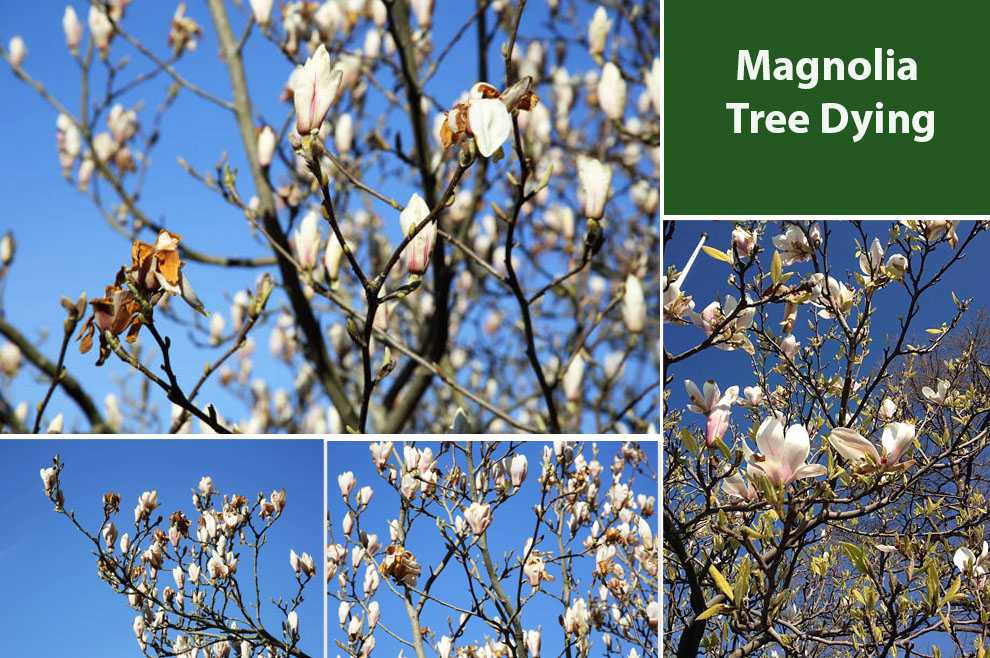
Magnolia trees are cold-hardy, but like every other tree, even they are susceptible to some diseases and problems that can hamper their health, resulting in Magnolia dying if you do not take measures timely. Moreover, assessing the reasons for the plants’ dying can be pretty stressful.
Many even refer to them as Laurel Magnolias, Swamp Magnolias, and Tulip trees that usually grow up to eighty feet tall with a spread between thirty and forty feet.
Do you also have a sick Magnolia tree that does not seem to get better, regardless of how hard you try? Do you often wonder, ‘why is my Magnolia tree dying?’ If this sounds like you, we are here to help you.
Typically, the Magnolias die because of too little or too much water in the root system. Also, if the surrounding winds have been too high, then, too, the plant might look like it is dying. Having said that, these are not the only reasons for magnolia’s poor health.
Let us look at other possible reasons for Magnolia not growing well.
Why Is My Magnolia Tree Turning Brown and Branches Dying?
Multiple problems might cause the Magnolia trees to turn brown and even kills their branches. While some might be easy to identify, others might take some time and are often challenging to fix.
Below, we will address some prevalent reasons for Magnolia tree branches dying. Knowledge of these reasons will help you rectify the problem before it worsens. Here are some of the top causes and their solution:
A. Frost Damage
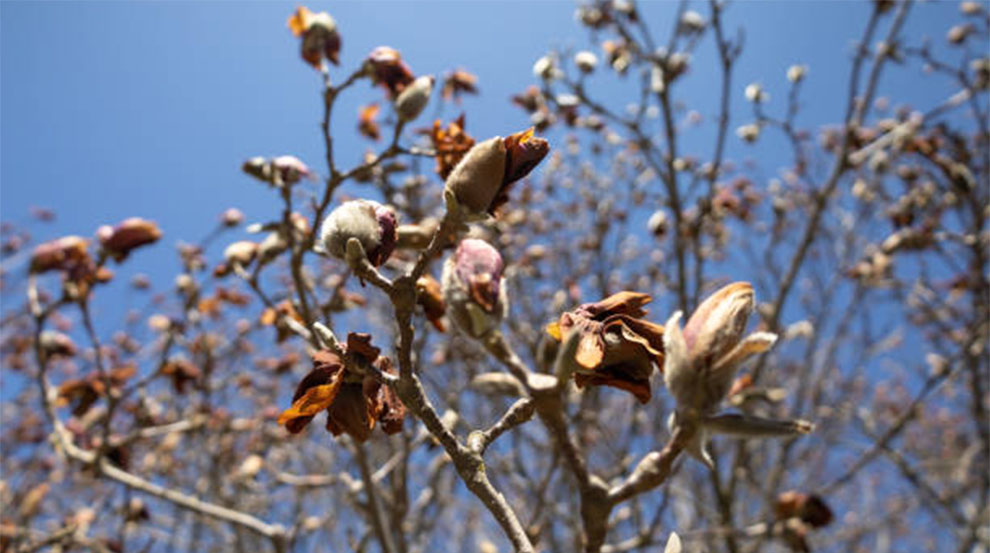
Some Magnolia trees are more cold-hardy than others, but most Magnolias thrive in USDA zones four through nine. So, when you see your Magnolia branches turning brown, it might imply frost damage.
The risk is more prevalent in the early blooming Magnolia trees, susceptible to damage by spring frosts in the North. If the petals have brown blotches and the flowers are gloomy, they may be affected by frost.
Fortunately, winter leaf scorch and frost damage do not kill the tree. But they ruin the plant’s appearance for a while. Sadly, there is not much you can do to avoid frost damage, especially on the mature specimen when the damage is already done. But, if you have just bought a small plant from the nursery, you must choose the planting location that keeps the plant guarded against frost.
In any way, if you have a small tree, you can also throw a sheet or a covering on it during the night or whenever you anticipate a frost in your location. However, do not forget to remove it the next day.
For mature Magnolias, the options are limited. But here are some things you can try:
- Soak the soil around the plant’s root zone. The air temperature above the damp ground is warmer than above the drier ground.
- Spraying an antitranspirant on the leaves can protect against the problem of Magnolia tree branches dying. You can also set up a patio heater if you have one near the plant but not too close to the foliage. When running such devices, be cautious and follow the safety instructions.
B. Too much sun

Magnolia trees thrive in warm and sunny regions. However, the excess sun exposure during the hot temperature damages the Magnolia tree. You can see the sun damage in multiple ways.
- Excessive sun results in wilting leaves that eventually fall off the tree.
- Magnolia blooms turn brown and wilt.
People usually think that to prevent further damage, you must dig the tree up and plant it in a new location with more shade, but we do not recommend it. Also, it is not possible for a big grown tree. Instead, plant the taller trees around the Magnolia. It will create shade and offer relief from the intense heat and light of the sun.
- Further, excessive sun heat makes the plant lose its moisture.
Thus, you must water the plant thoroughly, particularly during the hot weather. In addition, you must surround the tree with pine straw or mulch to trap in water, ensuring that the Magnolia trees stay moist for longer during the hotter weather.
C. Canker Diseases
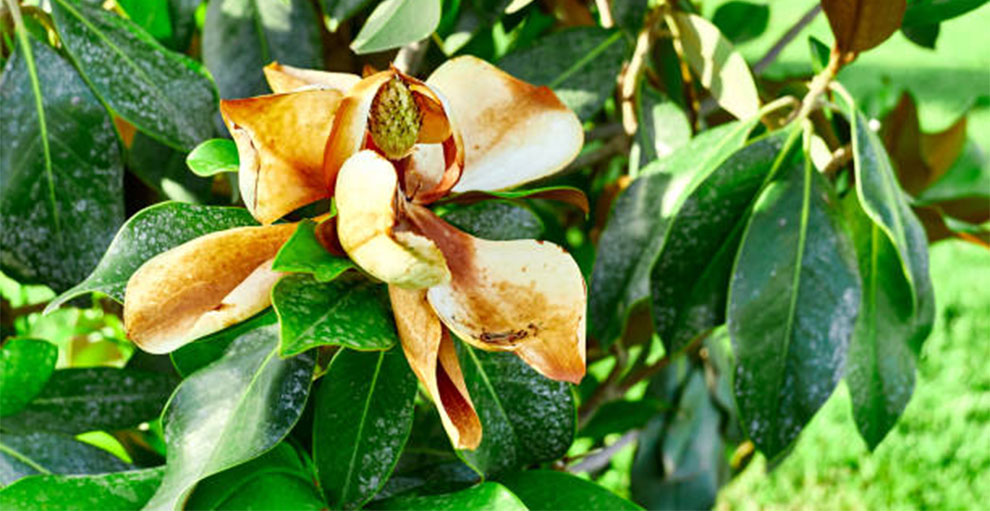
Canker diseases are predominantly associated with open wounds infected by bacterial or fungal pathogens. They weaken the plants. In some cases, they might be the reason for Magnolia dying.
Over time, the infected part breaks free, usually during extreme weather conditions. Once the sunken patches show, the leaves turn brown or yellow and start wilting. You can consider pruning the infected branches to ensure the disease does not spread.
However, if the infection is severe, you might lose the tree. If that happens, you must not plant any new Magnolia in the same spot.
D. Root rot or overwatering
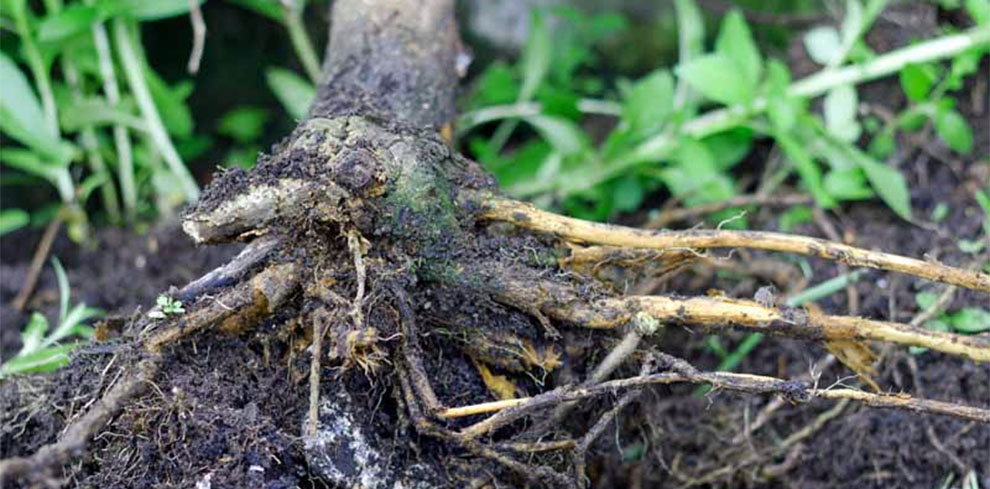
When someone asks us, ‘why is my Magnolia tree dying,’ our first instinct is to inspect for fungal infections. These are the most prevalent culprit in killing a Magnolia tree.
Rot root might stem from fungal Pythophthora species like Cinnamomic and Cactorum. At times, soil pathogens might also be an underlying cause. Root rotting mainly occurs when you overwater the trees in warm weather, triggering pathogen growth.
Eventually, the leaves wilt and the branches die when the root rot aggravates from the roots to the rest of the plant.
To overcome this issue, avoid overwatering and let the soil dry out before rewatering. In addition, you must clean the debris accumulating around the tree to prevent pathogen growth.
E. Insufficient Watering
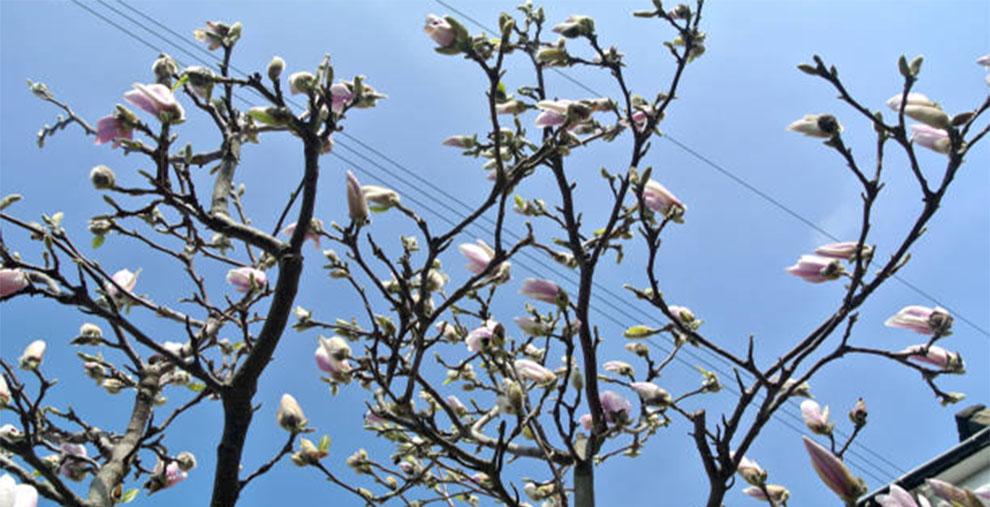
If your Magnolia leaves become brown in the summer, you are not watering enough. However, high winds might be another culprit for drying foliage. But insufficient watering is a more severe problem, but browning foliage does not necessarily mean the tree is dead.
So, be patient and give your plant some time to recuperate. To avoid this issue, understand the plant’s watering requirement and water the plant only when the top soil feels dry.
Further:
- If you reside in areas with harsh winds, plant all new trees in a sheltered region.
- Ensure that the root zone is evenly moist.
F. Verticillium Wilt
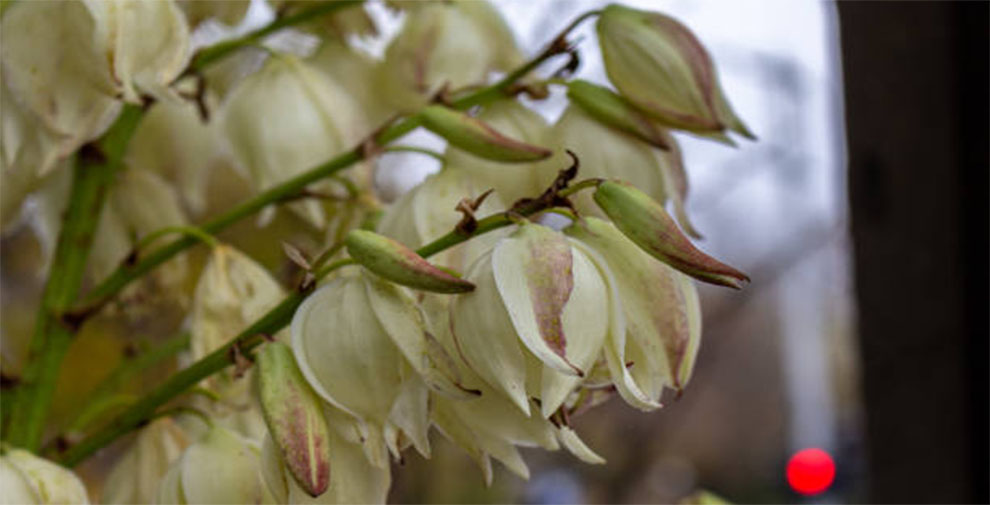
It is one of the top diseases resulting in Magnolia dying. Initially, the disease kills the branches one by one, and eventually, the entire plant dies.
So, if you think Verticillium wilt is the reason for dying Magnolia trees, you must initially inspect it by cutting a part of an infected branch as big as your finger’s width. Now, check it for vascular discoloration. Also, check whether the branches appear brown or look red.
As a preventive or remedial action, you must avoid the wilt’s spread and prune all the infected branches. While pruning, ensure that you disinfect the shears between cuts to prevent the disease from spreading.
Next, disinfect your shears by soaking them for five minutes in a solution containing one part of water and one part of seventy percent isopropyl alcohol. Lastly, dry the shears.
G. Transplant shock
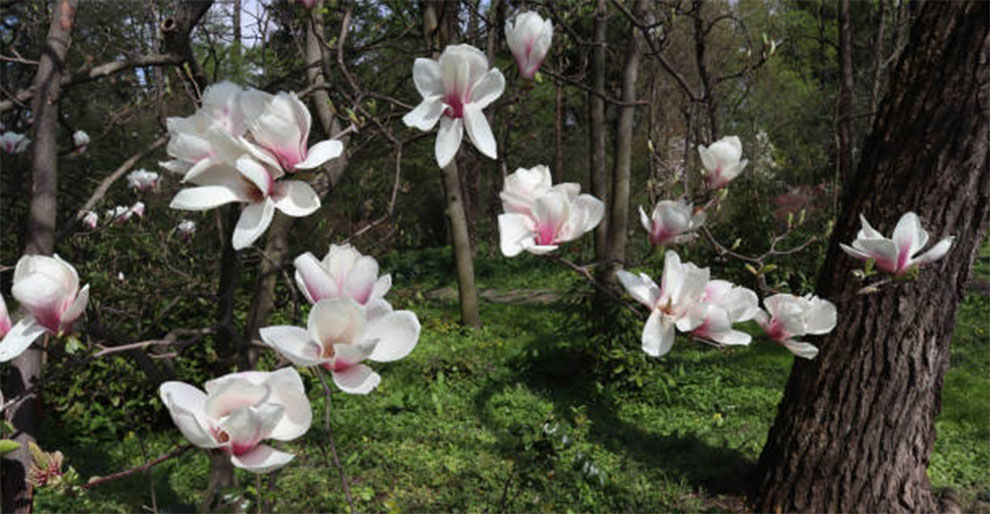
When you move your Magnolia tree to a new location, it takes time to regain normalcy. It is known as transplant shock and might often result in browning in the foliage. If you are not cautious, it might even kill the plant.
To minimize the transplant shock, follow these tips:
- Pick the location wisely.
- Water the Magnolia an hour before transplanting.
- Prepare the planting site before digging the Magnolia. Ensure the hole is of the same depth as the root ball. Now, plant it at the rootball level with the soil line.
- Ensure the rootball stays intact by securing it with cardboard or burlap.
- Use a wagon or wheelbarrow when moving the plant to its new site.
- Employ guy wires to ensure that the newly planted tree does not lean when established. Once established, remove the wire.
- To prevent damage to the bark, slide the rubber hose sections onto the wire where it touches the trunk.
- After planting, spread mulch around the Magnolia to help the roots retain moisture.
- Water regularly to keep it properly hydrated, especially in the first year after transplantation.
H. Nutritional deficiency
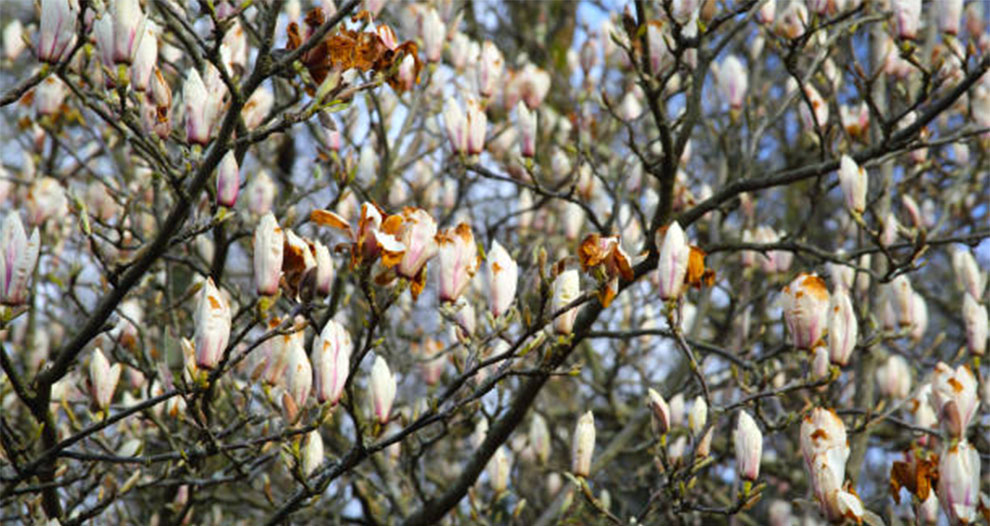
If the leaves look brown in summer or spring, they may immediately drop off the plant following a color change. It is indicative of iron deficiency. If not taken care of timely, it can result in Magnolia dying.
So, perform a soil assessment test to know the soil’s content. You can request the county extension office for a soil sample check. If there is a nutritional deficiency, pick a fertilizer to fix it.
I. Phytophthora infection
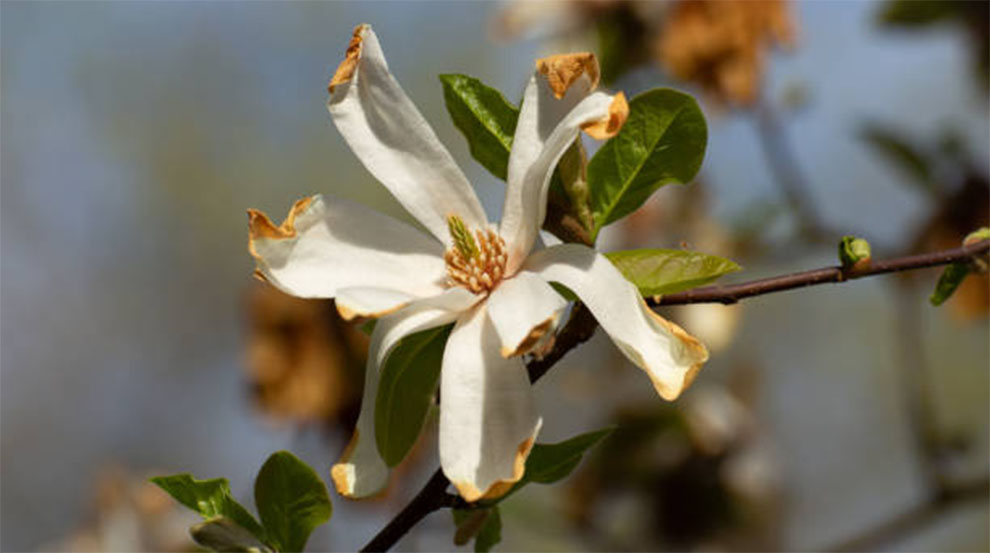
Root rotting might also occur because of the Phytophthora infection. On Magnolia trees, multiple Phytophthora species are to be blamed, such as Phytophthora Parasitica, Phytophthora Cinnamomic, Phytophthora Cryptogea, Phytophthora cactorum, and Phytophthora citricola.
Overwatering becomes the breeding ground for these soil pathogens, invading the plant roots, causing the leaves to wilt and drop, and killing the branches. To prevent this, avoid overwatering and let the soil dry out between two irrigations.
In addition, clear the debris surrounding the tree’s base as that, too, might trigger pathogen growth.
What Could Be The Possible Reason If Your Magnolia Tree Suddenly Died?
Generally, Magnolia trees die because of the moisture levels and the ground conditions around them. If you overwater it, making it impossible for the plant to drain out excess water, it might kill the plant.
So, account for the plant’s watering schedule according to its species. Overwatering can be a reason for severe concerns. For instance, overwatering often results in waterlogging. It appears as discoloration in the foliage, bark, stems, and roots and eventually kills the plant.
Further, if you plant the trees in soil that is not well-draining, even that might result in your tree dying. Moreover, if you do not water the plant as required, that might also justify the dead Magnolia.
So, if the Magnolia tree suddenly died, the primary issue is almost always associated with water. To prevent root rotting or waterlogging, monitor the ground conditions.
Also, the high winds may burn the Magnolia. So, if you are following the watering schedule properly and your plant is still dead, it might be because of the wind.
The windy situation results in the leaves falling from the tree and turning brown. If that happens, your tree is not in critical danger but still demands time and remedial actions to heal.
What Does A Dying Magnolia Tree Look Like – Symptoms That Should Alarm You
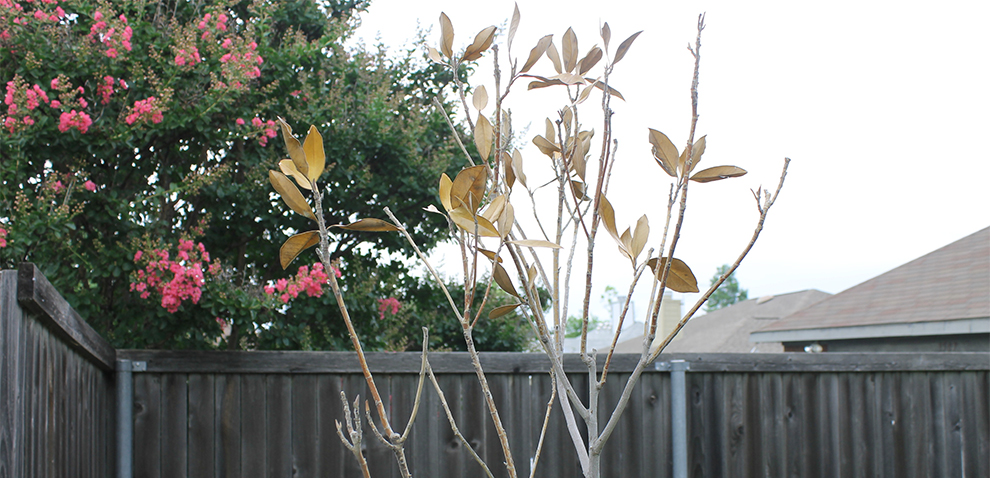
If you suspect an underlying problem with your Magnolia tree, you must inspect it thoroughly for some signs. Below we will enlist them:
- A dead or a dying Magnolia will shed more leaves than usual.
- Its foliage will begin to change its colors, usually starting from yellow and then eventually turning brown before finally dropping onto the ground.
- The tree might have brittle wood, trunk cracks, and decay areas.
So, these are the three giveaway signs of a dying Magnolia. Usually, a sick Magnolia shows signs with its discoloring foliage and later advances to more severe symptoms.
However, if the complete sections of the tree are lifeless, then it might be too late to save it. Having said that, eliminating the dead parts helps the plant concentrate its energy and resources on the healthy part.
But it is usually a hit or miss. Sometimes Magnolia dying is a natural process, and there is no way to keep it alive.
How To Revive A Dying Magnolia Tree?
Here are some ways to revive a dying Magnolia:
A. Understand the problem
You can only provide a solution if you know the reason for a dying Magnolia tree. So, firstly try to identify the cause. Watch out for brittle or dry wood, lack of leaves, decay, or cracks on the trunk.
B. Rectify the watering issue
Magnolia trees typically die because of overwatering or underwatering. So, understand your plant’s watering needs and water it accordingly. Ideally, watering when the topsoil feels dry suffices.
C. Use light mulching
Even though mulch is good for the trees, excessive mulching can be dangerous. Ensure that mulch is not too tight or thick around the base of the tree. Thick layers tend to choke the roots, so keep them light and airy. Mulching can help prevent fungal & bacterial infections.
D. Fertilize cautiously
Before you reach the conclusion ‘why is my Magnolia tree dying,’ perform a soil assessment to pick the right fertilizer for your Magnolia variety. Fertilizers can do more harm than good if not chosen right.
So, follow the packaging label before fertilizing the Magnolias. Never spray or sprinkle the fertilizer too close to the tree. Also, make sure you never use any infected materials as organic fertilizer ingredients.
E. Prune properly
At times, without the right pruning techniques for magnolia trees, they might get further damaged. So, cautiously remove the diseased parts to trigger new growth, and put away the dead or infected branches to prevent the disease’s spread. After pruning infected parts, sterilize the shears.
Related: Magnolia tree lifespan | Magnolia growth rate
Frequently Asked Questions
Ques 1. What is the life expectancy of a Magnolia tree?
Ans. Usually, Magnolia trees live between 80 and 120 years.
Ques 2. Can a Magnolia tree with no leaves recover?
Ans. Since the Magnolia tree is deciduous, it loses its leaves in winter. Such Magnolias will recover as the leaves come back in the growing season.
But, if a disease is responsible for a Magnolia tree losing leaves, you must study the signs and perform remedial action. While in some cases, it is possible to revive the plant, if the Magnolia is already dead, you may be unable to bring it back to life.
Ques 3. Do Magnolia branches grow back? What to do with them?
Ans. Sadly, the dead branches do not come back to life. So, it is best to chop them off.
Ques 4. How do you prune a dying Magnolia tree?
Ans. With the hand pruning shears, remove all the diseased, dead, weak, or dying stems, especially if it is a newly planted Magnolia tree. Chop the branches at a quarter of an inch from the side shoot. Water the sprouts and remove the suckers.
Summing up…
So, whether you have an existing Magnolia in your garden or intend to plant one, it is vital to know how to care for magnolias. Magnolia trees usually die if they have too little or too much water.
Typically, they start by changing colors or losing leaves and then advance to a more severe level of sickness as time progresses. To avoid this, inspect it routinely to assess the soil moisture levels, and plant it in a site that receives at least six hours of sun every day.
